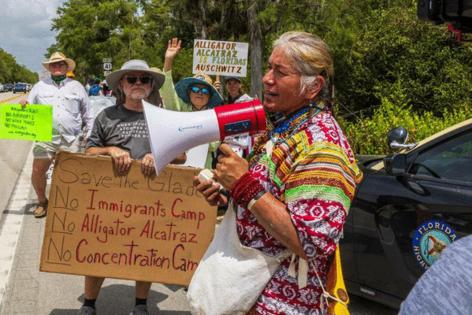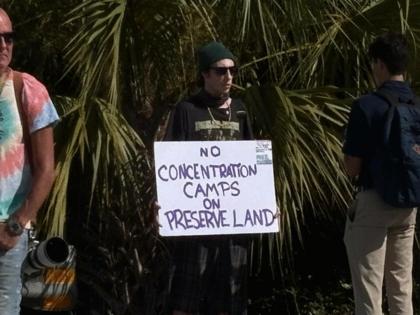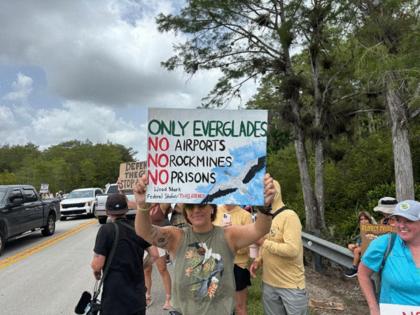Detention center driving out wildlife, damaging Everglades, critics contend
Published in News & Features
MIAMI — The sales pitch for erecting a detention center for detainees in the heart of the Everglades is the swamp and creatures surrounding it. The wildlife has become both a presidential punchline and the government’s official name for the controversial camp: Alligator Alcatraz.
But environmentalists worry that the rapidly constructed facility — which they contend sidestepped all required environmental permitting — will be harmful to the animals and ecosystem that surround it. Contrary to Gov. Ron DeSantis’ claims of “zero” impact, they say parts of the property are already are being covered in trucked-in dirt and rock — possibly damaging surrounding wetlands and robbing habitat from Florida panthers, bonneted bats and wading birds that normally frequent the site.
They warn the increased number of people and facilities on the property comes with an increased risk for spills into the sensitive waters nearby — and the fear that the “temporary” facility may well morph into something permanent.
“This project has been rushed through with zero analysis of the impacts of all of the vehicles and thousands of people who will be detained or work on the site. That is contrary to law,” said Alisa Coe, deputy managing attorney of Earthjustice, one of the groups suing the federal and state government to stop the detention center, at a Tuesday press conference.
“The Everglades deserves more, which is why we’re in court.”
But proponents of the project, which is set to house anywhere from 1,000 to 3,000 detainees in bunk beds ringed with fences inside temporary tents, say it’s being built on land that was already cleared for a 10,500-foot runway and administrative building — not untouched swampland.
DeSantis, who has campaigned on his record in the Everglades and stresses the state’s investment when talking about the controversial detention center, has dismissed environmental concerns.
“Obviously, I’ve invested how much billion and billions of dollars into increasing and improving the hydrology of the Everglades,” he said at a press conference Tuesday. “If I thought somehow this was going to hurt that I obviously wouldn’t do it.”
Lawsuit on NEPA
Environmental groups filed a lawsuit last week to stop the facility on the grounds that it completely bypassed the federal rules for assessing environmental harm, the National Environmental Policy Act or NEPA.
Paul Schwiep of Coffey Burlington, lead attorney for the case, said he has found no exception that applies to allow the federal government to skip this step.
“In the rush to get this done, the federal government and state have totally thumbed their nose at NEPA,” he said on a Tuesday press call. “Why? Because they say there’s no environmental impact.”
That, the environmental groups argue, isn’t true.
They point to a steady stream of dump trucks ferrying dirt and asphalt to the site all week — to expand on the paved areas of the site that already exist.
“When the governor says they haven’t expanded the footprint at all, that’s just wrong, and the proof is in the photos,” Schwiep said.
Schwiep asked the federal judge in the case to block the site from opening Tuesday, but the judge has yet to review or rule on that request, even as state officials trumpeted the arrival of the first set of detainees Wednesday evening.
“The request for an injunction does not become moot the moment a detainee steps foot on the site,” Schwiep said.
Eve Samples, head of Friends of the Everglades, is leading the charge on the lawsuit. The group was initially formed decades ago by Marjory Stoneman Douglas specifically to fight the development of a jetport on this exact plot of land, which she called “one of the most ecologically sensitive regions of Florida, arguably the United States.”
This new lawsuit is a continuation of that fight, she said.
“Remember, the jetport wasn’t halted until one runway was built,” she said.
Conservation or detention?
Two weeks ago, multiple suitors were in line to potentially purchase the Dade-Collier Training and Transition Airport, a 6,000-acre property with one long runway in the middle of Big Cypress National Preserve.
The Miccosukee Tribe was in loose talks to purchase the property and conserve it, and the state of Florida was interested in snapping up the land to use as a staging ground for hurricane supplies while agreeing to halt any future development on the rest of the site. A few years ago, Rodney Barreto, chair of the Florida Fish and Wildlife Conservation Commission, suggested Miami-Dade should donate the land to the federal government to increase the footprint of the preserve.
“The Jetport property is ecologically important to the health of the entire Everglades,” he wrote.
Now, the property is covered in tents, trailers, generators and rows upon rows of portable bathrooms — far from the vision of conservation many environmentalists had hoped for.
Curtis Osceola, senior executive policy adviser for the Miccosukee Tribe, said the tribe sees preserving this property as “critical” to the success of the Western Everglades Restoration Project.
“I don’t think there’s any debate that this is perhaps one of the most important features of WERP to restore, just because of the volume of water that gets diverted, mostly to the east, by this runway,” he told the Miami Herald.
Animals at risk
While the most common human visitor to the mostly idle airport over the years has been pilots of small planes practicing their “touch and go” flight maneuvers, environmentalists noted that plenty of animals and birds that once called the site home will likely be displaced now.
“It has massive impacts on the species that call Big Cypress home,” said Elise Bennett, senior attorney for the Center for Biological Diversity, during a press conference Tuesday. “We will not stop our work until we know they’re protected.”
She’s particularly concerned with the endangered Florida Panther. Fewer than 300 still survive in the wild, mostly in the preserve. About 20 to 30 a year are killed in car accidents, and multiplying the number of trucks and vans moving in and out of the site could increase the risk of squashing even more.
“To lose any more is simply untenable and would prevent the survivability of this species,” she said.
Data from the Florida Fish and Wildlife Conservation Commission show that the site has been a popular spot for panthers over the years. But the most recent ‘ding’ of a confirmed visit — from a panther wearing a radio collar to track its movement — on the site itself was from 2008. The most recent visit from a radio-collared panther near the site was in 2014.
Bennett noted that fewer panthers wear radio collars today than they did in decades past, and there are also far fewer of the big cats roaming Florida’s last remaining wild spaces, so this isn’t the full picture of how often these endangered animals may pass through or near the property.
The new floodlights and bright lights at night on the site are also a hazard for Florida bonneted bats, the rarest bat in the nation. Tribal members who live nearby have already reported that light pollution from the site makes the sky glow from miles away, potentially scaring away the tiny nocturnal creatures.
“To put any kind of development in the middle of this haven is really a death knell,” Bennett said.
Spill risk
One of the biggest environmental concerns that worries advocates: Potential spills of fuel, sewage of other damaging chemicals of material.
Year-long court battles have been waged over exactly how clean the water in the Everglades has to be without fouling up the whole system. The answer? Pretty darn clean.
Everglades advocates say that the portable bathrooms, diesel fuel for generators and potentially jet fuel for deportation flights all represent toxins that could harm the nearby waters if they spilled.
Osceola said the tribal neighborhood near the site has a couple hundred Seminole and Miccosukee residents who have spent decades designing and financing solutions to move toward cleaner water and sewage treatment that are less harmful to the environment.
“The government wants to inject about 10 times the amount of people in an even more remote location. The intensity is definitely going to come with some problems that basically have to do with creating a city in the middle of nowhere,” he said.
“Eventually you’re going to have runoff into the water supply. You’re going to have a situation when there’s a storm.”
On opening day of the facility, a typical South Florida rainstorm dumped about an inch and a half of rain on the site, enough to cause puddles to form inside the newly constructed tents and soak the bases of the twin U.S. and Florida flags brought in for the ribbon cutting. The state says it quickly solved the problem.
©2025 Miami Herald. Visit at miamiherald.com. Distributed by Tribune Content Agency, LLC.












Comments